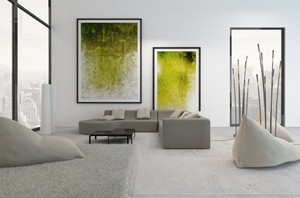
Art is a term that covers a huge range of trends and creative expressions. From sculpture to music to dance, there are so many different forms of artistic exploration that it's difficult to define the practice.
With painting, sketching, stencilling and photography just a few of the possible art forms able to be hung on the walls of your home, it could be challenging to choose the right display.
When you purchase the perfect piece of art, knowing how to present it can make all the difference. Removing the picture from a stark white gallery and introducing it into your busy, colourful home may alter the vision and ultimately leave you disappointed.
So, how do you decide on the right display to help your new art piece look its best? Here are three quick tips for decorating your home to support your masterpieces:
Frame for style
Choosing the correct frame is a big part of making sure art pops on your living room walls. While you typically don't want to the frame to outshine the art, some pieces may require a more visible outline to stand out from the other features in the space. However, not every kind of art needs a frame at all. So if you belive the art could stand alone as a bold statement on the wall without an outline, feel free to leave it floating.
Essentially, there are three main schools of thought when it comes to framing. Firstly, the gallery style means using simple wooden or metal frames that border the art without embellishing or distracting in any way.
Secondly, an intricate decorative frame will add to the piece by giving it a more grandiose feel, and separating the art from the features you possibly have around the room. Finally, a more modern framing trend is to forgo the whole affair and purchase your art on a canvas that can be hung sans frame.
Wall colour counts
When hanging your art, the colour of the support wall can make a big difference on its impact. Your first decision needs to be choosing between cohesion and contrast. In some cases, muted tones and pastel colours are the best bet to make sure your art is the feature. However, a bold wall colour choice can contrast the art enough to make the picture and its frame stand out on an already eye-catching section of the room.
To decide, take a walk around a local art gallery and note how many walls are painted with a cool near-white tone like Resene Alabaster while some pictures are supported by a brighter and more contrasting hue, such as the vibrant plum red of Resene Pompadour. This is because not every piece of art works well against a white wall. Some require the influence of a background colour to properly pop.
Accessories matter
Depending on where the art is hanging, your accessories can have a big impact. Do you have complementary pieces standing on a shelf below the picture, or perhaps a feature plant or lamp standing nearby?
These items can help draw the eye to the right part of the room, but can also distract from your art, so be careful when choosing your pieces.
It is also a good idea to balance the colour. A good choice is to complement your art with a feature accessory set close by. For instance, a grey-heavy abstract painting with a splash of red would sit well above a dark stone fireplace with a Resene Countdown feature mantle.
In fact, one of the best supports for your art is to ensure the entire decor is cohesive and complementary – even when contrasting. Try picking pieces from a similar era or style, like matching an abstract painting with modern furniture and other items.
Of course, while accessories can help give art emphasis and underline your pieces, be careful of cluttering the space and distracting the bigger picture.
The most important thing to remember is that art is subjective. So, choosing the colours, pieces and displays that you like can be just as vital as following these guidelines. If you think the art looks good, then nothing else really matters.


